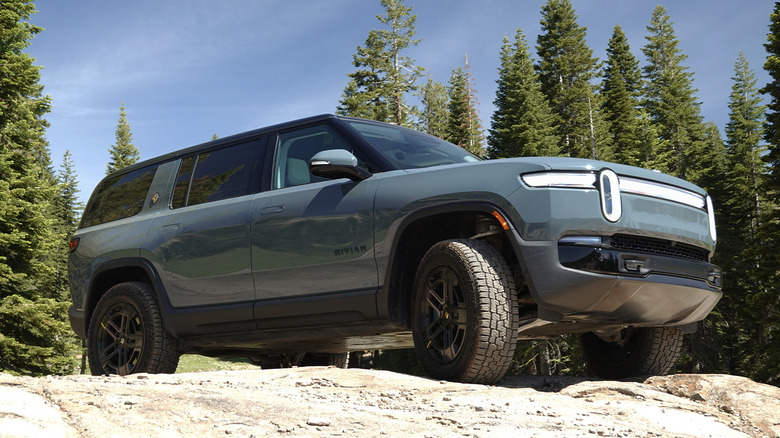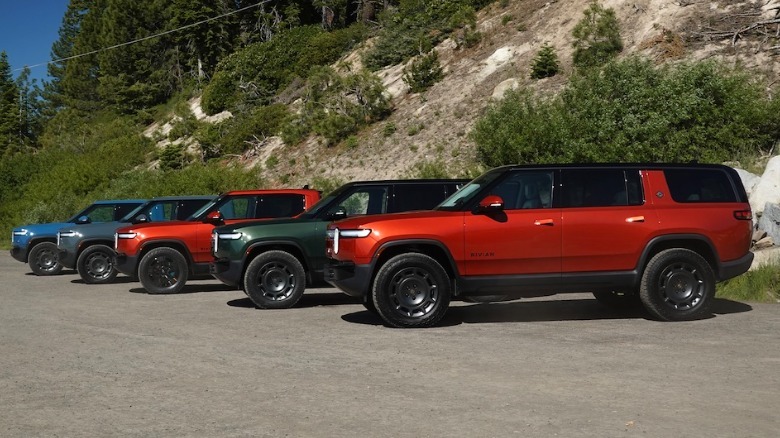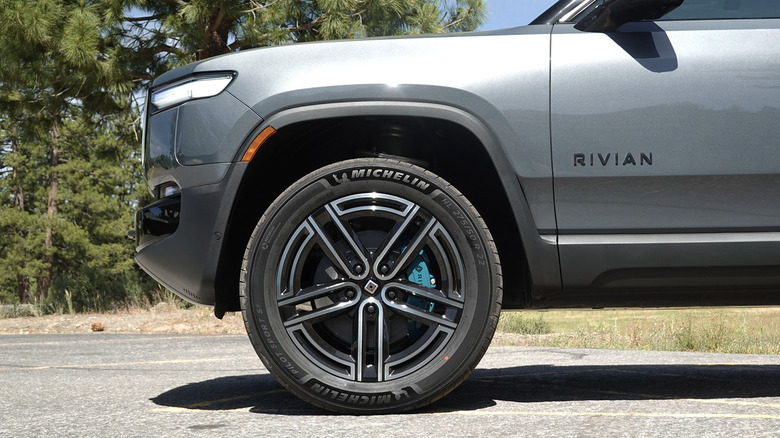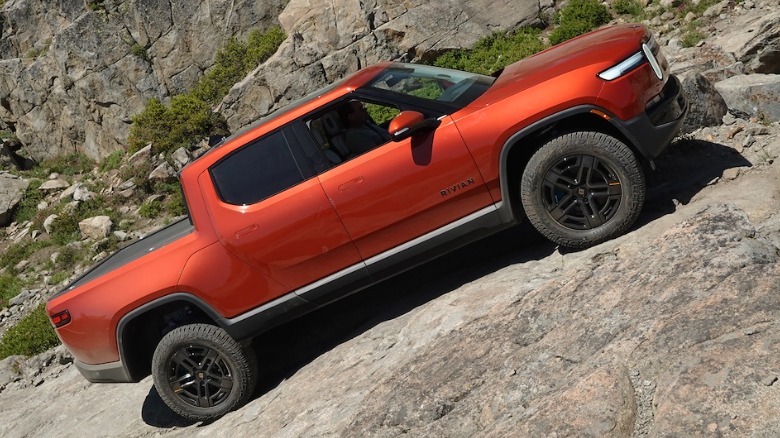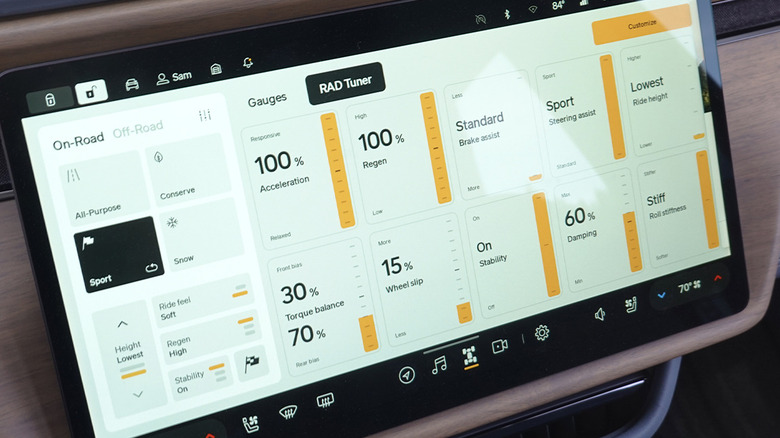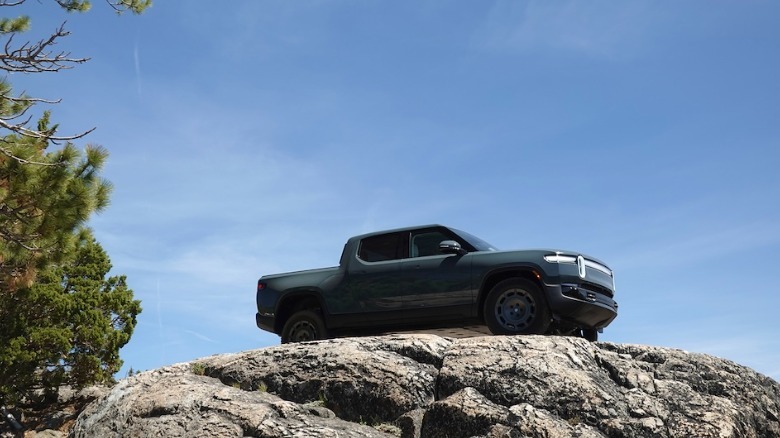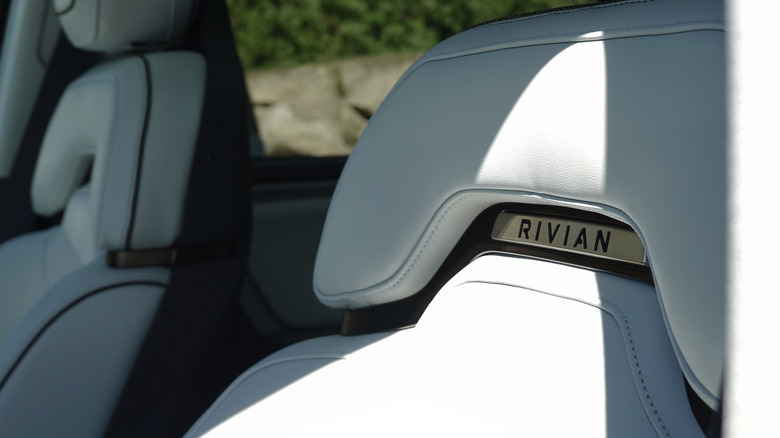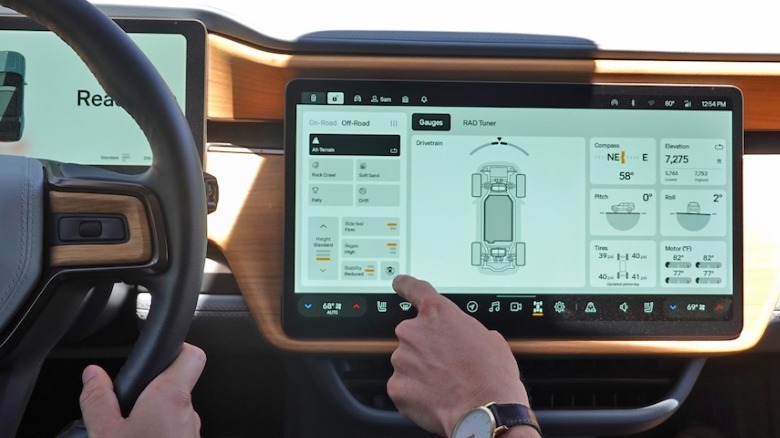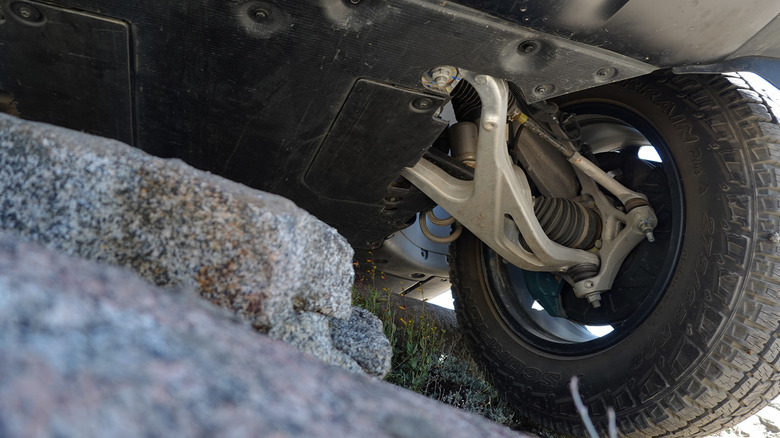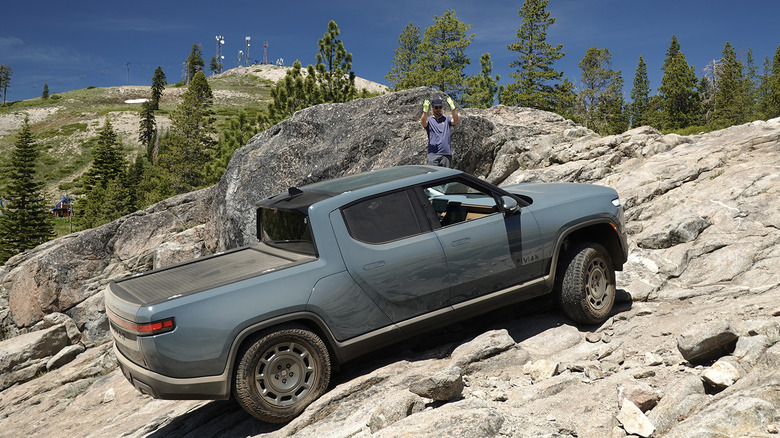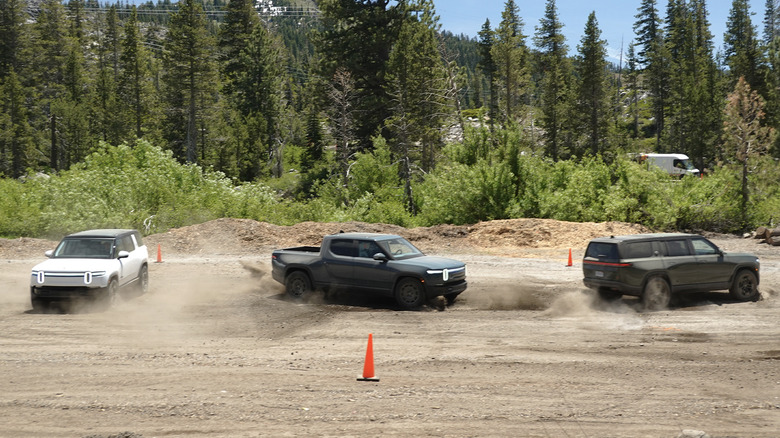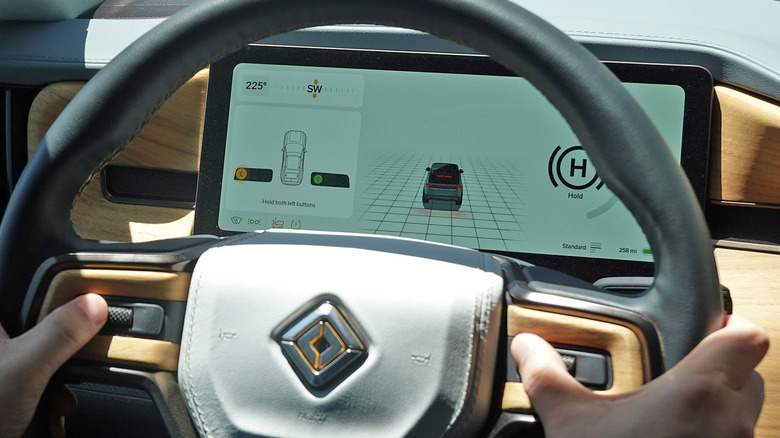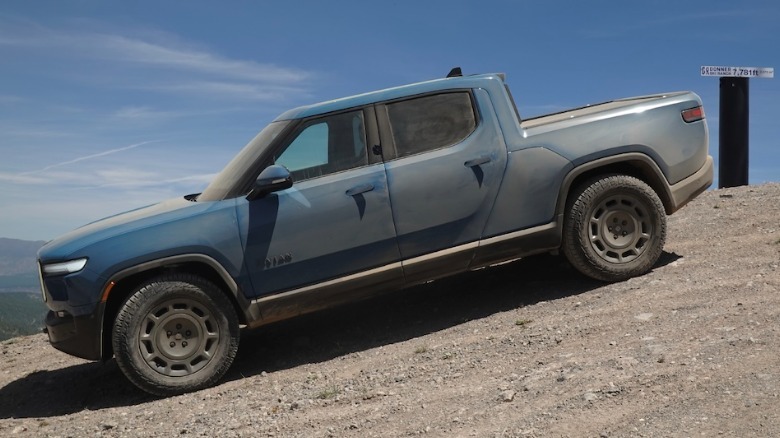Rivian's R1 Gen 2 Quad-Motor EVs Drive Like Supercars (And Spin On-Demand)
Gen 2 of the Rivian R1S and R1T debuted this year, and both now include a new Quad-Motor variant at the top of the model lineup. For the most part, the SUV and truck's respective designs remain unchanged, an usual decision from Rivian but a good one given the easily identifiable and popular styling. Instead, beneath the boxy and futuristic exteriors, the Gen 2s now feature major improvements to powertrain and technology that results in additional output and range simultaneously.
The Quad-Motor R1S and R1T then take all the Gen 2 enhancements and max out the potential for on-road performance and off-road capability. New motors and additional cooling allow for ratings of 1,025 horsepower and 1,148 lb-ft of torque, while a new RAD Tuner program takes advantage of nearly every possible driving parameter. Plus, a fun new "Kick Turn" mode spins the Rivians in place like a top, and even allows for clever, easily executed drifts.
Both the SUV and truck wind up as impressive packages with equally daunting prices, at $121,990 and $115,990 respectively (and final range numbers still to be settled, though figure on around 374 miles on the EPA's test cycle). But I recently attended Rivian's media launch program around Lake Tahoe hoping to learn whether the Gen 2 Quads can rectify some of my least favorite attributes of previous models.
Refining the original Rivian recipe
In some ways, the Gen 2 design could have highlighted the Quad-Motor designation slightly more. Take a look at the Laguna Beach blue brake calipers and Gear Guard cartoon character to be certain, essentially, though even more subtle blue badging surrounds also cue at the top-spec powertrain within. The interior also features similar textural wood dash and upholstery options—comfortable, roomy, spacious, and definitely tech-forward. But why not take the generational update as an opportunity to clean up the dash's central climate control vents, a clear oversight in the original design, or soften up the rock-hard headrests?
The technical underpinning of Gen 2 represent an effort to reduce the complexity created by multiple waves of engineers that worked overtime to produce the original R1T, and the R1S that followed. Cutting 10 ECUs throughout, from 17 to just seven, helps to save a total of 1.6 miles of wiring per vehicle. New motors for those power figures include a front with a new silicon-carbide inverter that improves cooling, plus new final drive ratios. The suspension retuning both helps to prevent squat during hard launches, while harnessing the additional grip of available staggered Michelin Pilot Sport S5 summer tires available to unlock the claimed 2.5-second 0-60 time for the R1T (and 2.6s for the R1S).
RAD Tuner totally changes the game
Now throw in the additional battery and motor cooling, better cameras with eight times the megapixels, a new autonomous driving processor that runs 200 trillion operations per second... Not bad for a second effort. But RAD Tuner and Kick Turn definitely take the cake for the most noticeable gains, so I asked Rivian's resident Pikes Peak record-holder Gardner Nichols about how these features came about.
"RAD Tuner is something that we've wanted to do for a long time" he replied. "We've been at various races and events over the years, which are the ultimate proving grounds, and testing our vehicles in various surfaces like sand or snow for instance. While in development, our team will be doing some sort of maneuver in the vehicle and think, 'You know, this is fun, but it'd be even more fun if we could have power to the rear or allow this amount of slip.'"
Turns out, while racing at Pikes Peak in the record-setting Quad prototype last year, Nichols worked through many of the same functionality, though not while using the nifty RAD Tuner sliders.
Anybody can imagine Pikes Peak racing
"At Pikes Peak, we were pretty much setting those parameters, but on the back end using the software deep in the vehicle and figuring out what could be done and what is actually useful," Nichols revealed. "With a feature like RAD Tuner, we're giving customers a tool to customize their experience. We have engineered our drive modes for the vast majority of situations, but RAD Tuner allows users the flexibility to cover the other parts, or make tweaks to the presets for their personal preferences. We like that our customers like to adventure. We know that people like to curate their experiences, even down to the details of their drive mode settings. So we wanted to give them a fun and unique way to responsibly create their own modes."
Kick Turn requires less conceptual details, at first glance, but the ability to take the electric G-Wagen's "G-Turn" (more commonly known as Tank Turn) and then do so while driving sets big things in motion—quite literally. So, to sum up: new Riv, new you. Big upgrades, new features, top-spec Quad back in the lineup. But how does all this translate to actual real-world driving, on-road and off? Well, few places can provide a more perfect opportunity to explore the new Rivians than around Lake Tahoe and the Donner Pass.
Brutal acceleration from this electric SUV
On asphalt, I mostly wanted to toy around with RAD Tuner. But first I needed to acclimate to the big power bump because without exaggeration, the R1S that I started out driving harnesses lightning in a bottle. On my first try, I ripped off a 3.15-second 0-60 time—without prepping the tires, on asphalt torn up by skiers and tire chains all winter, and on a slight uphill grade. All just by using Launch Control, one of the simplest such applications that I've experienced yet.
But simply adjusting to digging deeper and deeper into the go pedal (can't call it a throttle anymore, can we) required a mental leap, as this 6,825-pound SUV hit true supercar speeds with ease. Still, the steering created an odd disjointed effect, as on previous Rivs. Excessively power assisted, yet fairly precise, somehow the system combines too much road feedback as every little pebble and microscopic crack visibly shakes the steering wheel itself, but then zero weight sensation while cornering and a complete lack of return to center. I sometimes even imagined I could feel the electrical components themselves working, tiny gears clicking together as the wheels and tires turned this way and that.
Finetuning the Rivian's suspension and steering
Much of this I attribute to the suspension and steering components working together to manage EV weight. Rivian early on decided to spring for (pun fully intended) a hydraulic roll control system rather than traditional sway bars, but the combo of hydraulic fluid and air suspension clearly struggles to keep wheel travel in check while holding the skateboard chassis as level as possible. Using RAD Tuner, though, I fiddled and futzed with the settings to find the best combination to improve steering feel and ride quality simultaneously.
Of course, such sensitivity by nature requires a hefty dose of subjective preference, but for me, I preferred keeping the roll stiffness to the softest of three modes, the damping at 40%, the ride height low, the steering on Standard, and the torque split rearward at 70:30 to allow a bit of power from the front wheels.
Ideally, I wanted to find somewhere between the rigidness of a Porsche Dakar, which Rivian's Sport setting reminds me of, and the effortless flow of a mid-engined McLaren, where the hydraulic roll control originated. But also while allowing some of that weight to actually help damp any of the jittery nature of the hydraulics and airbags working in concert, which allows such a large and heavy vehicle to roam more freely rather than masking its true character.
Hydraulic roll control: pros & cons
Of course, hydraulic roll control brings some advantages to the table versus a traditional sway bar. The system opens up a wider range of use cases, beyond even the most advanced disconnecting or adjustable sway bar, while also packaging more neatly within a skateboard EV layout. And once we turned off the asphalt—after plenty of journalist launches and skids and hard corners—the additional articulation that Rivian's independent suspension allows certainly came into play.
Now in an R1S equipped with the optional 20-inch wheels and a square set of matching Pirelli Scorpion All-Terrain tires, I took on some mild obstacles while switching between All-Terrain and Rock Crawl modes. The wheel articulation reared up as I felt full droop and full compression more than a few times, but mostly that hydraulic roll control kept the chassis squared up and climbing steadily. Still, I repeatedly heard and smelled tires scorching over bare rock, and thumbed back through the gauge clusters on the center touchscreen to check my tire pressures.
Debating whether to air down or not
The readout showed 40 PSI all around, or fully inflated to standard roadgoing pressure. But a Rivian rep claimed that all the rigs destined for the off-road demo ran on 28 PSI tires. Oh well, I left my tire pressure gauge at home, but just looking at the sidewall compression, suspect my truck actually stayed aired up the whole time. Not that other drivers fared any better, as I discovered after hopping out to shoot some pics. Sure enough, everyone kept spinning a tire or two with surprising regularity.
Regardless, nobody needed a tow or even to back down and try again that I witnessed. Again, not bad for a caravan of EVs that all probably weighed well over 7,000 pounds factoring in occupants and gear. But I spent much of the time comparing the Quad-Motor's performance to the Mercedes-Benz G580 with EQ Technology, quite possibly the most impressive off-roader ever. Perhaps some quick math off the spec sheets explains the difference: the Rivian Quads just about double the power output of an electric G-Wagen. So does the off-road confidence come down to German experience and skill with traction control programming, or simply too much power—which we love on asphalt, of course.
Kick Turn mode comes naturally
The Gen 2s got the job done, just not quite as happily as I expected given the potential of four-wheel electric motor control. So I'd argue that Rivian missed an opportunity to introduce a locker-style torque delivery program. Maybe with more time, I might have just turned down the power output in RAD Tuner. But soon enough I needed to hustle over to the Kick Turn demo (where the G-Wagen came to mind even more).
In this case, however, the Rivian took the cake handily with a much more intuitive activation process, plus the ability to spin in place or rotate while already driving at speeds up to 15 miles per hour. I cued up Gear Guard doing a jump kick on the center touchscreen, then practiced a few pirouettes with my thumbs on the steering wheel buttons.
Pushing into throttle started the spin, then once I moved onto Kick Turning in motion, I quickly began initiating a drift before finishing off a hard arc with more throttle and countersteering. The system works wonderfully—though I sat in the backseat as a colleague practiced and cannot recommend doing so—though Rivian did program in limitations to preserve driveline components, so Kick Turn will not work on asphalt to prevent sheared axles and CV splines. Definitely a good idea, given the six-figure pricetags of these two new legitimate supertrucks.
2025 Rivian R1 Gen 2 Quad-Motor Verdict
So the Gen 2 Quad-Motors add serious engineering enhancements, a host of thoughtful improvements, and even enable the activation of a liveable combo of steering and suspension settings with in RAD Tuner that help mitigate my main issues with previous Rivians. Prime settings, I call them, but I still think a few more details deserved attention in addition to the aforementioned nits that I needs-must professionally pick.
Namely, adjusting the air vents through the digital screen still sucks, I hate full glass panoramic roofs especially on an EV, and I do want a glovebox. How about using all those cameras for an invisible hood mode to compensate for that big, square expanse above the frunk (another Mercedes reference, interestingly)?
No doubt that while upgrading this top-of-the-line flagship for another generation, Rivian needed to prioritize investment simultaneously on the forthcoming R2 SUV and even smaller (and more affordable) R3. The Quad-Motors nonetheless improve noticeably, and we must remember exactly how many small details and major decisions must go perfectly right for any car company to produce a running and driving vehicle, let alone a relative startup trying to bust into a major industry. Hopefully, Rivian can continue this upward trajectory, and further foster the takedown of Tesla at the top of the EV industry through a healthy dose of healthy competition.
